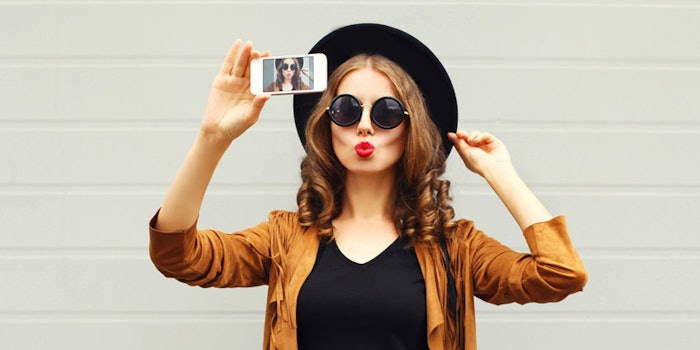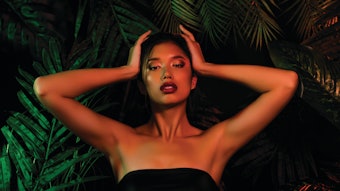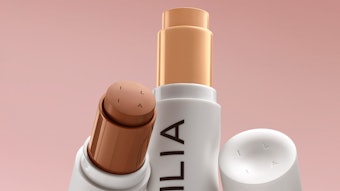
Color cosmetics are expected to do so much more than enhance natural appearance or create a glamorous look. Today, it’s also about looking your best—indeed, perfect—for the smartphone camera. Social media has fueled this desire for perfection and brands are responding with innovative products and apps to appeal to digitally-aware consumers.
Beauty brands are responding with a new twist on traditional products, such as foundation, blusher, highlighter, eye and lip products.
Enhanced mobile technologies mean that anyone can take a selfie using the camera on their phone or tablet. If it’s not good enough, then there are numerous tools at the user’s disposal to improve their picture-making skills.
Young women, particularly millennials, are the most engaged demographic group and like to post selfies online on various social platforms, including Instagram, Snapchat, Facebook and Twitter. Therefore, the need to be photo-ready is essential.
HD Beauty
Beauty brands are responding with a new twist on traditional products, such as foundation, blusher, highlighter, eye and lip products. The jargon used is designed to entice women looking for HD-perfect skin through the use of words such as “Photoshopping” and “filters.” For example, Sephora’s Colorful Eyeshadow Photo Filter Palette comes in two colorways: “sun-bleached filter” and “overcast filter.”
The latest trends in selfie makeup are coming from Asia, where beauty is not only taken extremely seriously, but to a whole new level.
Examples of other HD-touting products include Make Up Forever Ultra HD Foundation + Hydrating Skin Equalizer Customizable Set; Vita Liberata Body Blur Instant HD Skin Finish; Viseart Corrector, Contour, Camouflage HD Palette; Dior Capture Totale Foundation; Lit Cosmetics Holographic Lit Kit; and Wander Beauty On-The-Glow Bronzer and Illuminator.
Flawless and Photoshopped
The latest trends in selfie makeup are coming from Asia, where beauty is not only taken extremely seriously, but to a whole new level. For example, the region’s color brands are looking for new ways to connect with consumers, including collaborations with bloggers to create new products or shades, for example Korean blogger Pony’s collaboration with box subscription and e-commerce player, Memebox, which led to the introduction of Pony X Memebox. The range includes Shine Easy Glam Eyeshadow Palette, Pony Blossom Lipstick and Pony Easy Mix Block Blush.
“Many products, such as those in Japan, are claiming to be perfect from a 10-cm distance and from any angle, thanks to a blurring effect and light reflection pigments,” explained Florence Bernardin, company manager, Information et Inspiration, which specializes in Asian beauty trends.
The product is aimed at those wanting a quick touch-up when taking a selfie.
Bernadin will speak as part of the marketing trends program of the 2016 in-cosmetics Global in London, taking place April 4–6.*
A’Pieu Shiny Luster Lighting Pact SPF17/PA+ has a dual puff for different benefits: the coated side is for a light powdery makeup finish with a glow, and the reverse is for covering pores and keeping makeup in place for longer.
Beauty Blur
Leading Asian beauty brand Amore Pacific has introduced Etude House Beauty Shot Face Blur SPF15/PA+, with a blendable formula that creates a smooth finish and blurs out imperfections seamlessly for a flawless look. Its “baby Pixel Powder” (blur powder) is a weightless powder that ensures the color lays down smoothly while brightening skin tone.
Strobing by Any Other Name
Traditional products, such as blusher and highlighters are also getting a makeover, thanks to 21st century wording designed to appeal to connected consumers.
Apps leveraging VR technology include Urban Decay’s Vice lipstick app, which allows users to virtually try on 120 shades on their phone.
“Strobing is a new naming that is coming to Asia but, as a product effect, is not new at all,” said Bernardin. “It used to be called ‘shading’ or … ‘3-D effects,’ as many Asian women want to have a slimmer face that doesn’t look too flat. Similarly, light reflection has always been included in foundation to bring light to the face for a brighter skin tone—it is part of the Asian beauty ideal. I would say strobing is bringing new product formats such as convenient pencils or cushions to the beauty markets.”
Digitally Augmented Beauty
In the space of a few short years, the beauty market has been flooded with smartphone applications that specialize in helping consumers to discover make-up tips and products. And the latest technology coming from Asia has led to apps which can do much more.
Apps leveraging VR technology include Urban Decay’s Vice lipstick app, which allows users to virtually try on 120 shades on their phone; Perfect Corp.’s digital makeover app, YouCam Makeup; FaceCake Marketing Technologies’ in-browser augmented reality shopping platform for Cargo Cosmetics; and ModiFace’s skin tone Live Scan technology, which allows users to take a 3-D scan of any face or photo and convert it into a look that can be applied directly to their live video.
Mirror technology is opening up a whole new dimension through the ability to detect facial movement in real time.
One of the most straightforward apps is Shiseido’s Misette (translated as “let me see”) that allows users to share their makeup tips. Users can find the tips they want from a timeline, but can also search by facial parts, rankings or tags.
Beauty futurologist Antoinette van den Berg envisaged a future for makeup that is more egalitarian.
Once the look is complete, it can be saved and shared on social media, such as Facebook, Instagram, Snapchat, Twitter and Kakaotalk. The cosmetic items can be saved onto a smartphone. Furthermore, the products used for the virtual makeover can be purchased directly from Laneige.
A more lighthearted, whimsical example is Shiseido’s digital campaign for its 16-color Rouge lipstick. The campaign’s app allows two people to kiss each other virtually through the phone: two lipstick marks are captured, and then “Kiss Monsters” appear on the screen.
In October 2016, Beauty magazine Biteki cover-mounted a clip-on smartphone lens. The macro lens can take close-up photos, even of skin texture and pores, and can be used to check the effect of products on the skin. The wide-angled lens is designed to take a wide shot selfie using the smartphone.
Beauty for Everyone
Beauty futurologist Antoinette van den Berg envisaged a future for makeup that is more egalitarian and allows consumers to embrace their individuality. Van den Berg will also speak as part of in-cosmetics Global’s trend track in 2016.
“Transgender is a very important new group that will influence brands to take another approach to developing cosmetics,” she noted.
Van den Berg said that brands will look at this group differently and create a marketing blur, in the same way as some have when targeting older consumers.
Another change will be the creation of makeup that allows people’s unique imperfections to be visible.
Van den Berg predicted, “It may lead to a drop in sales of products for coverage, but create a new niche for transparent foundations.”
Imogen Matthews is a consultant to in-cosmetics. For more information, contact www.imogenmatthews.co.uk.
*www.in-cosmetics.com










